Saudi 3D printing materials producer and OEM Saudi Basic Industries Corporation (SABIC) has announced the European launch of its Thermocomp AM 3D printing compounds, specifically for large format 3D printing.
SABIC also debuted its new Lexan EXL filament.
Thermocomp AM, specialised for larger than life applications
SABIC’s Thermocomp AM materials have been developed for use in large-format pellet-fed extruders. The materials are reinforced with carbon or glass fibres, optimising them for use in the high temperatures and durability required for tooling, aerospace, automotive and defense applications.
Explaining SABIC’s move into large format materials, Stephanie Gathmnan, Director of Emerging Applications noted that “large format additive manufacturing is opening up tremendous new opportunities for producing large, complex parts with speed and precision.”
Gathman added that “SABIC also supports customers with world-class processing, design and testing capabilities at our U.S. Center of Excellence for Additive Manufacturing in Pittsfield, Massachusetts. These resources help customers accelerate application development for large printed parts.”
The Thermocomp AM compounds are based on the company’s existing ABS, PPE, PC and PEI resins. Each of these compounds exhibits low warping under high temperatures, and can be adapted depending on application with the addition of carbon or glass fibre.

Thermocomp AM’s maiden voyage
To demonstrate the large-format capabilities of the Thermocomp AM materials, SABIC displayed a section of the Livrea Yacht hull, designed and 3D printed with Autodesk at SABIC’s Pittsfield center.
According to Mike Geyer, director of Evangelism and Emerging Technology at Autodesk, large format 3D printing removed “need for molds and prototyping,” producing a yacht hull that was “lighter and stronger,” and “a fraction of the cost” of traditionally fabricated parts.
Joshua Chiaw, SABIC’s director of LNP Compounds and Copolymers stated that SABIC would now be assessing the large-format suitability of PBT, PA, PPS and PEEK.

Lexan filament
SABIC announced in October that it would use formnext 2017 to launch a new high-impact filament for FDM 3D printing, without revealing further details. This has now been revealed as the LEXAN EXL AMHI240F FDM filament, based on SABIC’s previous LEXAN PC filaments.
Apart from it’s high toughness, the EXL filament improved ductility at room temperature and at temperatures as low as to -30 °C, shown by a notched Izod impact test (featured image). The filament has a heat deflection temperature of 140 °C, higher than ABS filaments, and is UL94 V-0 flammability compliant at 3.0 mm in XY and XZ dirextions.
The EXL AMHI240F FDM filament features a 1.79 mm diameter and 1510 cc per spool. It processes at standard Stratasys print settings for PC.
SABIC is exhibiting at formnext 2017, hall 3.1, booth G78.
For more information on materials launches subscribe to our free 3D Printing Industry newsletter, follow us on Twitter, and like us on Facebook.
Featured image shows a notched Izod test showing tensile strength of normal filament versus SABIC’s new LEXAN EXL filament. Photo via SABIC.

